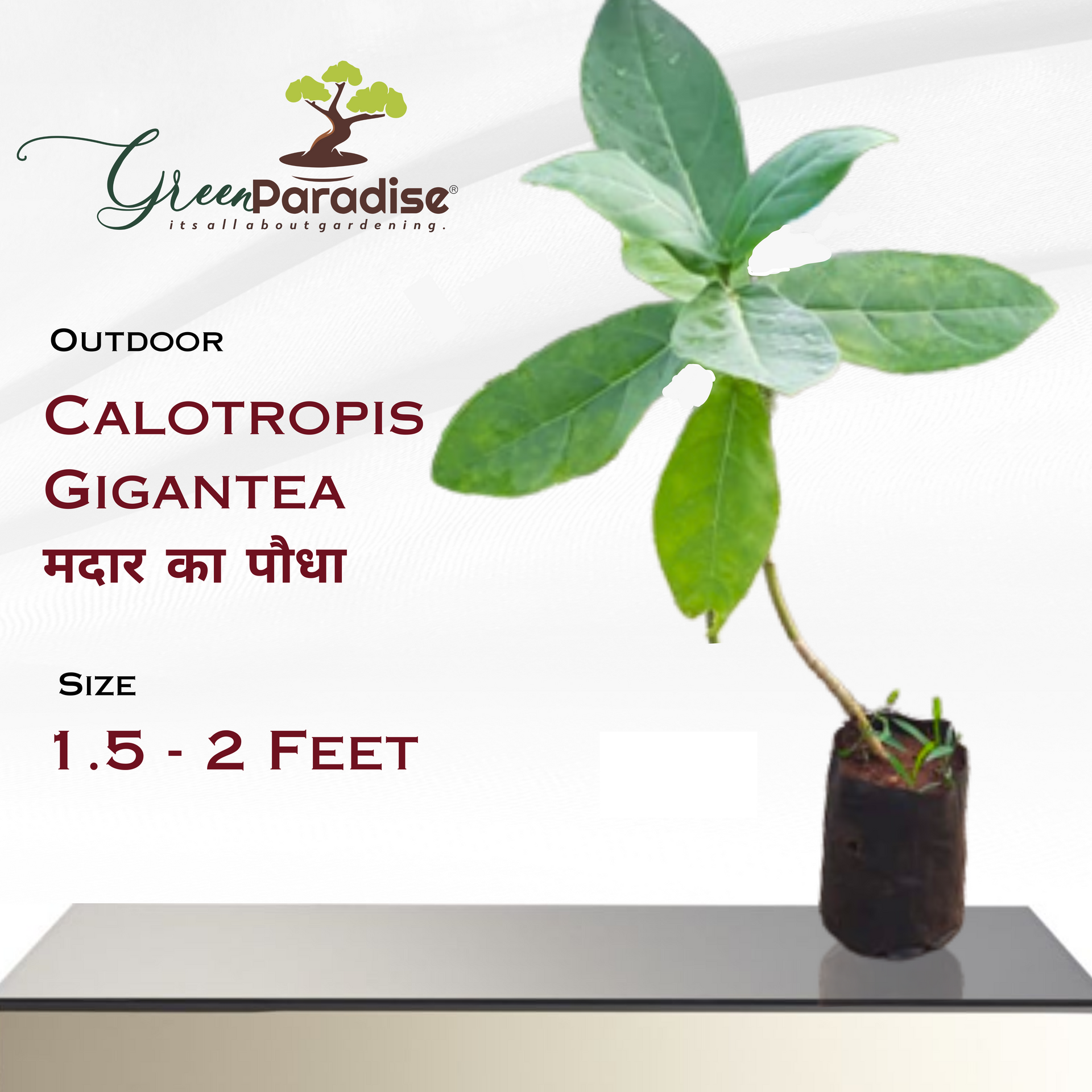

Calotropis gigantea Plant live Madar Plant
Guaranteed Safe Checkout
Exploring the Wonders of Calotropis
gigantea Plant: A Marvel of Nature's
Resilience
About Calotropis gigantea Plant
In the realm of botanical marvels, the Calotropis gigantea plant stands tall, both in stature and significance. Also known as the Crown Flower or Giant Milkweed, this magnificent perennial shrub has captured the attention of botanists, ecologists, and nature enthusiasts alike. Native to Southeast Asia and certain parts of Africa, this plant has managed to carve its niche in diverse ecosystems due to its unique features and remarkable adaptability.
Physical Characteristics
- The Calotropis gigantea, as the name suggests, is a truly gigantic plant.
- It can grow up to an astonishing height of 6 to 10 feet, adorned with lush, oval-shaped leaves that are pale green and velvety to the touch.
- However, it's the mesmerizing flowers that steal the show.
- These flowers, resembling a regal crown, come in shades of lavender, pink, or white.
- Their intricate five-lobed structure and waxy texture make them a magnet for pollinators like butterflies and bees.
Resilience in Challenging Environments
- What sets Calotropis gigantea apart from many other plants is its ability to thrive in a variety of conditions, even those considered harsh by conventional standards.
- It's often found growing on the outskirts of deserts, along roadsides, and in abandoned fields.
- This resilience is attributed to its efficient water management system and its leaves' ability to reduce moisture loss, making it well-suited for arid environments.
Medicinal and Practical Uses
- Throughout history, various cultures have harnessed the potential of Calotropis gigantea for medicinal purposes.
- In traditional medicine, the latex extracted from the plant has been used to treat ailments such as skin infections, rheumatism, and even as a natural insect repellent.
- However, it's important to note that improper usage can lead to adverse effects, highlighting the need for caution and proper guidance.
Ecological Importance
- Beyond its practical uses, Calotropis gigantea plays a significant role in its ecosystems.
- Its nectar-rich flowers are vital for sustaining local pollinator populations, thus supporting biodiversity.
- Additionally, the plant's leaves are known to be a food source for certain caterpillar species, contributing to the delicate balance of food chains.
Cultural Significance
- The Crown Flower holds cultural significance in several regions.
- In Hawaii, it's considered a symbol of royalty and is used in making traditional leis.
- In parts of Southeast Asia, the plant is associated with religious rituals and offerings, underlining its deep-rooted connection with local customs.
Landscape Ornament
- Beyond its natural habitats, Calotropis gigantea has found a place in gardens and landscapes around the world.
- Its striking appearance and ability to attract pollinators make it a popular choice for those aiming to create diverse and vibrant outdoor spaces.
Caring for Calotropis gigantea
- For those keen on cultivating Calotropis gigantea, it's important to provide well-drained soil, ample sunlight, and periodic pruning to encourage healthy growth.
- However, its latex can be toxic, so handling with care and avoiding contact with sensitive skin is crucial.
Growing Calotropis gigantea: A Guide to Cultivating
the Giant Milkweed Plant
Calotropis gigantea, commonly known as the Giant Milkweed or Crown Flower, is a remarkable and unique plant that holds a special place in both ornamental gardening and traditional medicine. With its stunning appearance and various uses, cultivating Calotropis gigantea can be a rewarding endeavor for gardening enthusiasts. In this guide, we will explore the steps and considerations involved in successfully growing and caring for the Calotropis gigantea plant.
Understanding Calotropis gigantea
- Calotropis gigantea is a perennial shrub native to tropical and subtropical regions of Asia and Africa.
- It is known for its impressive size, striking appearance, and a remarkable range of uses.
- The plant can reach heights of up to 10 feet or more, featuring large, glossy leaves and clusters of star-shaped flowers in shades of pink, purple, or white.
Planting Calotropis gigantea
Selecting the Right Location:
Calotropis gigantea thrives in full sunlight, so choose a location that receives at least 6-8 hours of direct sunlight daily.
Soil Preparation:
The plant prefers well-draining soil with a slightly alkaline to neutral pH. Prepare the planting area by loosening the soil and incorporating organic matter to improve drainage and fertility.
Planting Method:
You can start Calotropis gigantea from seeds or cuttings. If using seeds, sow them in pots or directly in the ground. If using cuttings, allow them to dry and callus before planting.
Caring for Calotropis gigantea
Watering:
While the plant is establishing its roots, it requires regular watering. Formerly established, it's fairly failure-tolerant and only needs occasional watering.
Fertilization:
Apply a balanced, slow- release toxin during the growing season( spring and summer) to promote healthy growth and flowering.
Pruning:
Prune the plant to remove dead or damaged growth and to maintain its shape.Additionally, pruning promotes flowering and new growth.
Pest and Disease Control:
Calotropis gigantea is generally resistant to pests and diseases. However, keeping an eye out for common garden pests and taking prompt action is advisable.
Support:
As the plant grows tall, it might require staking or other support to prevent it from bending or breaking in strong winds.
Utilizing Calotropis gigantea
Ornamental Use:
The striking appearance of Calotropis gigantea makes it an excellent choice for landscaping and ornamental gardening. It can serve as a focal point in gardens or as a hedge or screen plant.
Cultural Significance:
In many cultures, the plant holds cultural or religious significance and is used in various ceremonies and rituals.
Medicinal Properties:
Different parts of the Calotropis gigantea plant have been used in traditional medicine for various purposes, although it's important to note that its medicinal use requires proper knowledge and caution.






